I was telling Juan Pablo Lozano that I wanted to write an article about the best Mexican cheeses and I was looking for someone who’d be willing to step up and make a commitment, someone who’d actually say these are the cheeses our country can be most proud of.

“We’ll do it”, said Juan Pablo. “Juan and Ana and I will do it.”
And they did.

Juan and Ana are Juan Pablo’s parents. Together they operate a business called Los Rehiletes, a cheese-focused retailer with two locations in San Miguel de Allende, Mexico. We agreed to meet at Las Barricas, the wine bar located above one of Los Rehiletes locations in San Miguel’s Mercado Sano to talk and taste cheese.

Juan Pablo brought out two cheese trays, each with three very different but very intriguing examples. They spanned the cheese color wheel from a bright white to an almost orange.
Mexican cheeses are generally broken into two categories, the ones that had their origins and inspirations somewhere else in the world and the ones that are original Mexican creations.
“That’s how I’ve separated them”, said Juan Pablo. “Three are based on European classics. Three are distinctly Mexican.”

I looked at the tray of European styles and decided to slide the knife into the one in the middle, the one that I thought I recognized by the zigzag patterned rind.
It was love at first bite.
“Manchego?”, I asked.
“Manchego tres leches, aged six months”, said Juan Pablo.
“Tres leches?”, I questioned, knowing that traditional Manchego is made strictly with milk from a breed of Spanish sheep.
“Yes”, replied Juan Pablo. “There’s sheep, goat and cow’s milk in it.
The taste was sweet, fruity, nutty. As good as any aged Manchego I’d had and with more creaminess than I was used to. It was 12:30 in the afternoon but I was already imagining this Mexican Manchego with a sherry.
I’ve paid close to 1000 pesos a kilo for Spanish Manchego. When Juan Pablo told me that this Tipo Manchego from Jalisco was about half that, I knew it was coming home with me.
The Lozano Family’s next choice was the world’s most popular style of cheese, a Cheddar made from cow’s milk that originates in Guanajuato.

“What’s interesting about this one is that the cheese is aged up to a year not in Guanajuato but in Jalisco where the altitude, climate and humidity are much more favorable for producing a good Cheddar”, Juan Pablo told me.
“Do you like it? Do you think it rates with imported Cheddars”, he continued.
I told Juan Pablo that I thought it was a great tasting medium Cheddar. It would depend on the price whether it knocked the Balderson or Cabot off my grilled cheese sandwiches.

I did try it shredded and melted a few days later in a ham, cheese and chives omelet and couldn’t tell the difference from a medium Balderson so price was definitely going to be the decider. And closies would go to the local Cheddar.
And if you’re wondering why this Cheddar is more white and others are almost orange, this local version uses no artificial colors.
While I stole a couple more nibbles of the Manchego, I asked Juan Pablo about the name his parents had chosen for their cheese boutique and owning up to the fact that I’d Google translated Los Rehiletes before I’d shown up for the tasting.

“We liked it simply because the toy is such an important part of Mexico, such an icon”, said Juan Pablo. “Rehiletes can put a smile on any kid’s face. Going deeper than that we like how the colors spinning together symbolize the way the farmers, the workers, the retailers work together to make the cheese business successful in this country.”
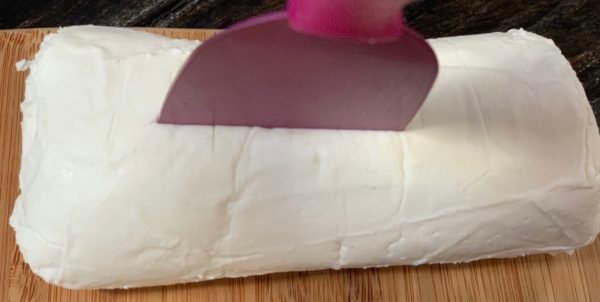
Third up was a French cheese that, surprisingly, I may have seen more of in Mexico than when I lived in France. It’s called Sainte Maure and originated in the Loire Valley region. How it became so popular in Central Mexico bewilders me, but it’s hard to walk into a cheese shop or even a supermarket without seeing it in a display case.
“I think Mexicans shy away from goat cheeses because they think they’re going to be too picante. That’s why they like Sainte Maure. It has a nice mild taste”, said Juan Pablo.
This Mexican Sainte Maure, which comes from Caraval, a farm that has been making cheese for three generations in Apaseo El Grande, about an hour south of San Miguel, is mild but still quite buttery and a little citrusy. I’m very fond of goat cheeses but I always think they need a companion. I took a log of this Sainte Maure home, smeared some on a sourdough baguette and added a little blackcurrant jam. It was a great way to finish dinner.
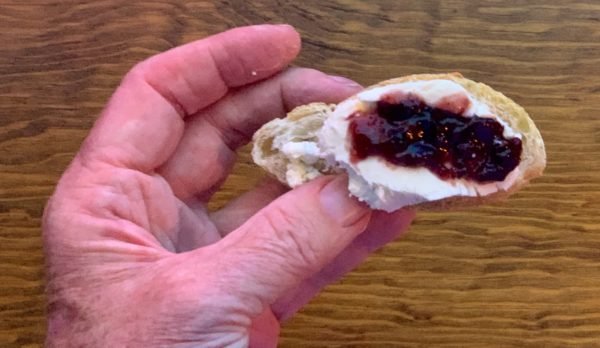
We were halfway through our tasting and I was impressed by Mexico’s interpretations of some of the European classics. From the time in the sixties when Mexican restaurants first arrived in Toronto and they drowned tacos and burritos and quesadillas in seas of bubbling butterfat, I have thought of Mexico as one of the greatest contributors to the world of cheese. Now I had had that world expanded. For the second part of our tasting at Los Rehiletes, we were going to sample some of the Mexican originals. I may have been looking forward to part two even more than part one.

Mexico now ranks tenth in the world in cheese production and, if there’s one cheese I think could take Mexico further up the ladder and penetrate more of the international market, it is the next cheese we tasted.
First up in round two was Cotija. I love Cotija…no, let me change that. Make that I love cotija with an asterisk. Aged Cotija would be right near the top of my personal best Mexican cheese list. Fresh Cotija, though, just doesn’t do it for me.
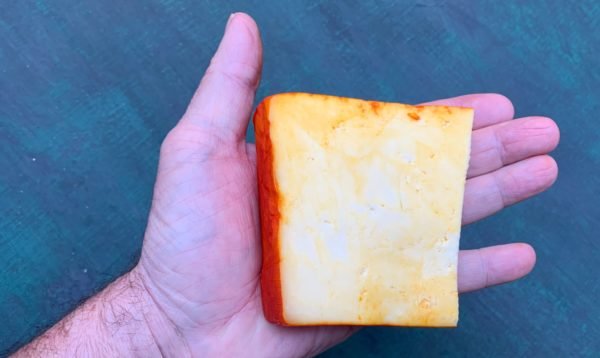
Los Rehiletes brought out samples of both styles of Cotija, a one-month-old and a two-year-old. I recognized the young one by the definitive rind; the achiote that’s used to color it is also what gives the rich red to Mexico’s legendary pork dish, cochinita pibil. Fresh Cotija shares the same two problems as many Mexican cheeses, a rubbery texture and a bland taste. Sometimes that can be changed simply by melting Mexican cheeses but not with fresh Cotija. I tried it again, toasted on a baguette with bacon and eggs, but it still didn’t work.

And then out came its older, much more tasteful brother; the two-year-old Cotija anejo was brought to the table. They call aged Cotija “The Parmesan of Mexico” and deservedly so. It does for Mexican bean dishes what Parmesan does for Italian pasta dishes. It’s a regular tenant in our Frigidaire and gets crumbled over salads almost as often as it does beans.
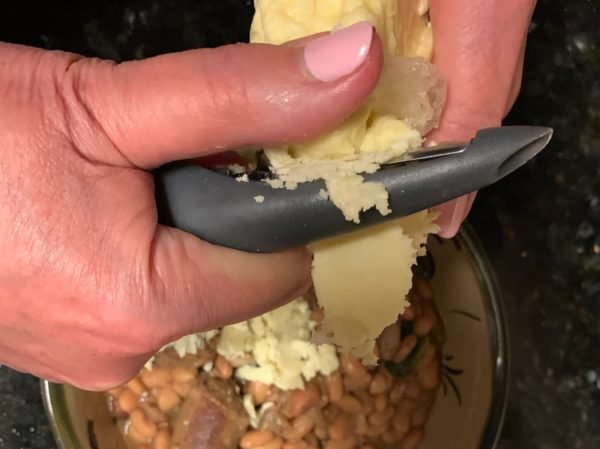
The cheese gets its name from a town in the state of Michoacán and that’s where Los Rehiletes’ Cotija comes from.
I’m always fascinated with how someone gets into the very gruelling retail business so asked Juan Senior about the beginnings of Los Rehiletes.

“It was about 12 years ago. We were living in Mexico City and Ana and I loved going out on day trips within an hour or two of our home. One weekend we found ourselves in the town of Aculco and there was cheese everywhere, cheese shops all up and down the calle principal”, said Juan.
“We asked the locals, ‘who’s the best quesero, who makes the best cheese in Aculco?’ The two words we heard were Don and Marcelo so off we went to find this Don Marcelo.”
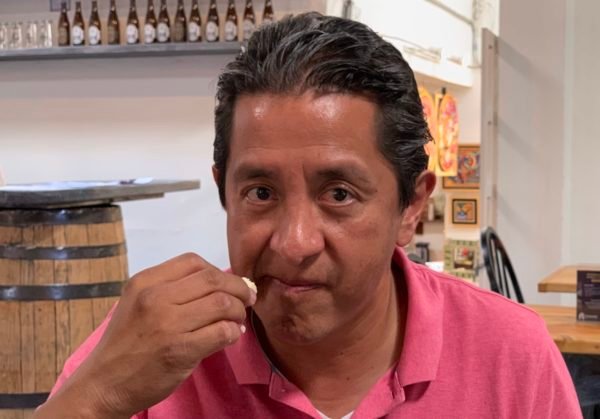
“The people were right. These were the best cheeses we’d ever tasted. We started to ask Don Marcelo all of these questions and he got quite protective. I think he thought we were trying to steal his recipes.”
As I was cutting one more chunk of Cotija, Juan Lozano cut to the chase.
“It wasn’t too much longer before we were buying Don Marcelo’s wonderful cheeses and selling them door-to-door. A year after that, we made two dreams come true. We made the move to San Miguel and opened Los Rehiletes.”

The next cheese at the tasting was introduced as Ana’s very best favorite cheese and, as I’d heard that Ana Lilia Sánchez gave up a dental practice to sell cheese out of a van, I respected her opinion enormously.

I was a little taken aback by her choice. I was expecting some creamy, stinky, exotic creation with an inedible rind and here was a cheese that looked like something I might have seen melted over nachos when I first ever tasted a Mexican cheese.
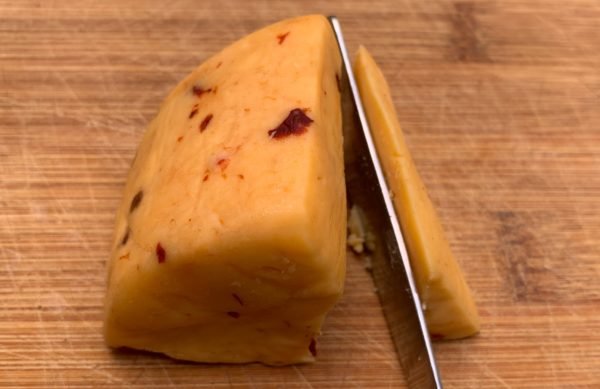
Visually, it was a delight: a deep sunshine yellow with speckles of brownish red. My knife slid through it like it would a young Cheddar. I took a bite, turned to Ana, nodded my head up and down and smiled. This was a very special cheese. A rich, creamy, buttery flavor with a very welcomed hint of chile. I imagined how good it might be in a quesadilla.
I suddenly felt very guilty, very pretentious, for turning my nose up for decades at all of those Mexican cheeses with their artificial dyes and their habañeros or jalapeños or walnuts or rosemary.

This cheese, that Juan Pablo called Chipotle Asadero and told me comes from our home state of Guanajuato, was so good, I had it twice in the next week, once melted over slices of baguette and, a second time, toasted on a croissant. At only $150 a kilo, it’s also very easy to justify eating it twice in one week.
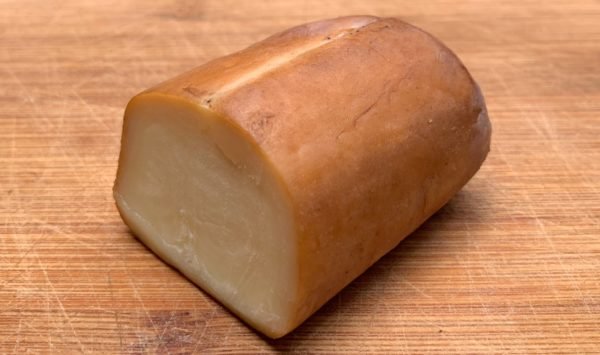
The sixth and last cheese was another that I was quite sure I recognized, this time by its log shape and color, but, if I was right, why was it with the original Mexican cheeses and not with the European-inspired ones?
“Provolone?”, I questioned
“Yes”, replied Juan Pablo.
“Then why wasn’t it with the first group?”, I asked.

“It could have been on the first plate but this Provolone’s a little different”, said Juan Pablo. “Most of the Provolones are made from cow’s milk. This one’s made from buffalo milk. And this one’s smoked.”
The stretched curd cheese had the familiar Provolone nutty and salty nuances and a smokey flavor that Juan Pablo assured me came from wood smoke not a bottle. The Provolone Ahumado de Bufalo originates in the famous Mexican cheese town of San Cristobal de las Casas in Chiapas.

My favorite way to enjoy smoked Provolone is baked over pulled pork but, with it takes five hours to braise a shoulder. So, later in the week, I paired it with salami on a toasted open-face croissant. It’s a sandwich I’ll make again.
I liked all of Los Rehiletes cheese selections except the fresh Cotija. I especially liked the Tres Leches Tipo Manchego, the local Cheddar and the Chipotle Asadero.
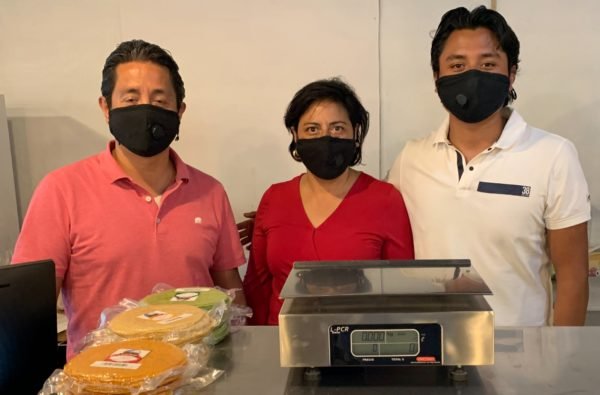
I liked all of the Los Rehiletes family as well. Juan, Ana and Juan Pablo are charming and delightful entrepreneurs and I felt privileged to be able to consume all of their personal knowledge of Mexican cheeses as I sampled their recommendations. I was also reminded of how much more pleasurable it is to buy from the little guy instead of in the cold, impersonal atmosphere of a supermarket. I was happy to discover that most of the cheeses I sampled aren’t even available in our local supermarkets.
Whether it’s re-interpreting the classics or creating unique originals, Mexico has a long history of cheesemaking and, when its recent innovations are included, can stand proud internationally. I left Mercado Sano stuffed with cheese and crackers but still hungry to be introduced to other Mexican cheeses. I plan to shop at Los Rehiletes again next week, purchase a couple of my new discoveries and also ask for one more brand new recommendation.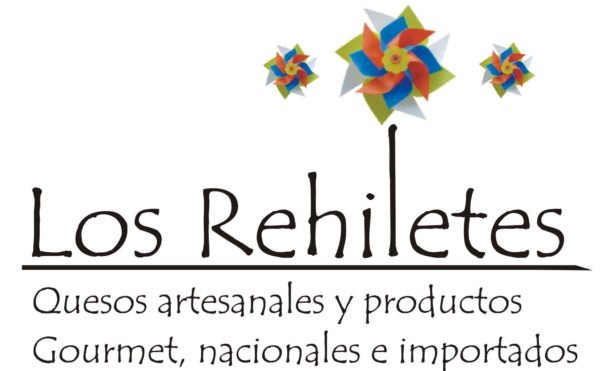
Los Rehiletes has two locations in San Miguel de Allende. The first is at Ancha de San Antonio 28C and is open from 9:00 am to 5:30 pm, Monday to Saturday; closed Sundays. The second location is in the lower level of Mercado Sano at Ancha de San Antonio 123. The hours there are 9:00 am to 5:30 pm, Monday to Saturday; 9:00 am to 3:00 pm, Sunday.

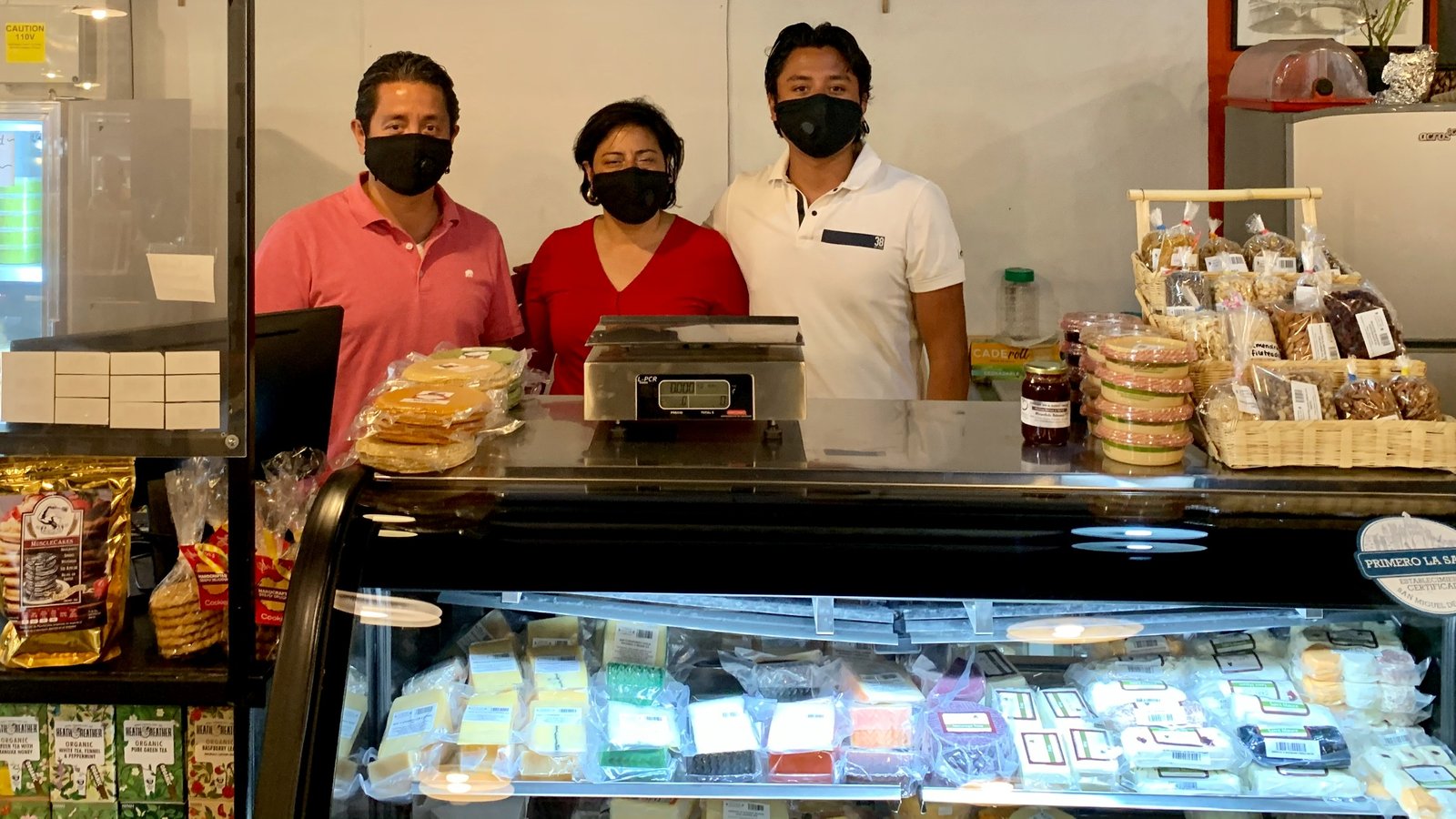
Very informative – as you are in a “cheesy mood” Don I would love for you to try our new organic and local Oreo cheese aged for six months from Rafa’s Lepperoni farm next to casa de aves in our little shop
Planning to visit your little shop this week. Will add the cheese to my shopping list.
Wonderful see you soon
LOVED this review as I have been ignoring these local cheese because of my ignorance…..thank you for enlightening and educating me. Also I would so appreciate where you have found good drinking sherry?
I like Fino Camborio or, if someone else is paying, Lustau Fino Single Cask. Both at Mercado de Vinos.
I love this article! Reminds me of one of the reasons I moved to Mexico! You help take the bite out of missing Anthony Bourdain’s show. I can almost taste these cheeses and will certainly visit Los Rehiletes. Now if I can just remember that word and add it to my Spanish vocabulary. Of course in translation, the name is great because the wheel part refers to a wheel of cheese. Gracias Don Day.
I really appreciated this article. I’ve been shopping at Los Rehiletes for many years, beginning when they just had a small shop on Ancha de San Antonio (and when Mercado Sano was Don Pedro’s). Always a pleasure to shop there. It’s great to know something about their history and more about the Mexican cheeses that you reviewed.
I enjoyed the interview with the family! We, too, have been shopping at both of their stores for quite some time. In fact, Los Rehiletes is listed in the Deli section of my map (Rhonda’s Centro Historico Guide & Street Map of San Miguel de Allende, 3rd edition).
Thanks I have been wanting to try some new cheeses for a while now but did not know what to ask for. Los Rehiltes have a very nice panela that comes from Celaya, very different to the big brands. Its nice to know the history of the owners and they are a great addition to our town.